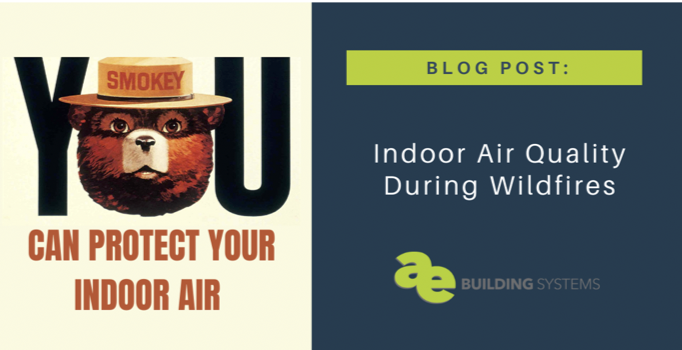
Smokey the Bear teaches us to help prevent wildfires, but Passive House Design and ERVs help teach us what to do to PROTECT indoor air when a wildfire is already happening! Those of us out west are no strangers to wildfires. They’ve become a regular topic of conversation in the summer months, and can be a crucial focus when living in the mountains. We often think about fire mitigation with trees and bushes, or having go-bags ready and a plan in place for evacuation. However, we don’t always think about how to protect the air we breathe when we’re living with wildfire smoke. And, when it happens, it’s something we simply can’t avoid.
“Climate change has been a key factor in increasing the risk and extent of wildfires in the Western United States. … Once a fire starts—more than 80 percent of U.S. wildfires are caused by people—warmer temperatures and drier conditions can help fires spread and make them harder to put out.”
Normally, we think about incorporating outdoor air to improve indoor air quality. But when a wildfire is occurring, the outdoor air quality is often much worse.
We have to think a little differently about how to maintain quality air indoors…
A Few Breathing Basics For Better Indoor Air Quality During Wildfires:
- Stay indoors as much as possible when wildfires are running rampant. In this case, indoor air is going to be more healthy than outdoor air.
- Keep windows and doors shut as much as possible.
- Wear a mask if you DO need to go outside. The US EPA recommends an N95 or P100 respirator mask with a NIOSH label.
- Window air conditioners should not be used during wildfires, unless their outdoor air intake can be closed.
- Consider a portable air cleaner to complement air sealing and filtering measures during a wildfire.
- Focus on airtightness. Leaks and openings are ways contaminated air can get in. This is where the Passive House design is a huge benefit. Many build this way for energy savings, but in this case, Passive Houses have a leg up on traditional construction in that they prevent contaminated exterior air from coming in. Listen in on a roundtable discussion where experts discuss how Passive House strategies can help.
- Use an ERV to help recirculate and preserve the quality of indoor air. This last tip seems a little confusing if you know how ERVs typically operate. We dig in deeper below!
Should We Use An ERV During Wildfires?
One big question we get is if ERVs are helpful when wildfires are happening. ERVs pull air from the outside in, so at first glance, this seems like something you’d want to avoid. However, experts say it’s actually still good to run the ERV. We need oxygen, and need to keep CO2 levels down. When we have too high of CO2, it can impact cognition, loss of consciousness, and even death.
Filters Used to Stave Off Wildfire Smoke
With the CERV2, the MERV 13 filters are considered sufficient to filtrate outdoor air – even during wildfires. The MERV 13 filters are much better than the MERV 8 filters, which are generally found in most ERVs. There is no need to add an additional filter to the inlet on the ERV during this season. What many people DO consider is changing to carbon or Colorfil filters to absorb additional odors and VOCs while smoke and ash are prevalent.
Automatic vs. Manual Ventilation
Operationally, when a wildfire is occurring, users can disable the VOC sensor from triggering ventilation and therefore would only be triggered by the CO2 sensor. If the smoke is extreme, or lasts for longer periods, you could also disable the automatic ventilation and manually ventilate with the system. For example, if it’s less smoky in the mornings, you might manually vent the system for an hour or so and then shut the ventilation off for the remainder of the day. With the CERV2, you can do this with your phone, tablet or computer and from afar. You don’t have to be home to adjust the controls. The main operational change to make would be to disable the VOC sensor from triggering ventilation and only go by CO2. During extreme smoke periods you may want to totally disable ventilation and then just manually trigger ventilation periodically. The pollutant sensors keep reading when disabled, so you will still see your IAQ data to know when to ventilate.
Recirculating Air to Maximize Indoor Air Quality
The CERV2 allows you to recirculate air. When you’re dealing with poor outdoor air quality, it’s important to recirculate indoor air as much as possible. This will continue to filter the inside air, further filtering any air that originally came in from outdoors.
Wildfires and Passive House Principles
The most effective strategy against particulate matter during a wildfire is an airtight building envelope. We achieve this by building with Passive House strategies as well as the strategic use of a CERV2 unit. Over the years, we’ve seen so many benefits to constructing home systems this way, but the recent wildfires, and the resulting poor air quality, make for an even stronger argument to focus on Passive House design for your next build!
What else have you done to protect your home and air quality during wildfire season? Reach out or comment to let us know. And, don’t miss the conversation over on Instagram around this topic and more around sustainable, energy-efficient construction!

Great tips!
The CERV2 now has an outdoor VOC sensor as an option. The user can view outdoor VOC data and enable VOC Prevention, which will automatically disable VOC triggered ventilation when outdoor VOC levels are high.